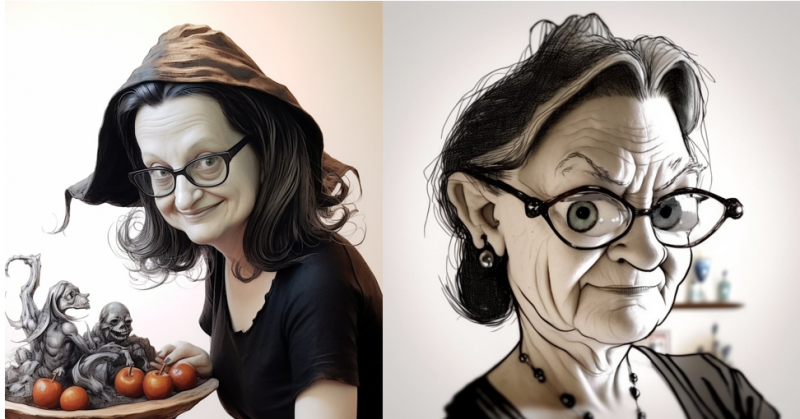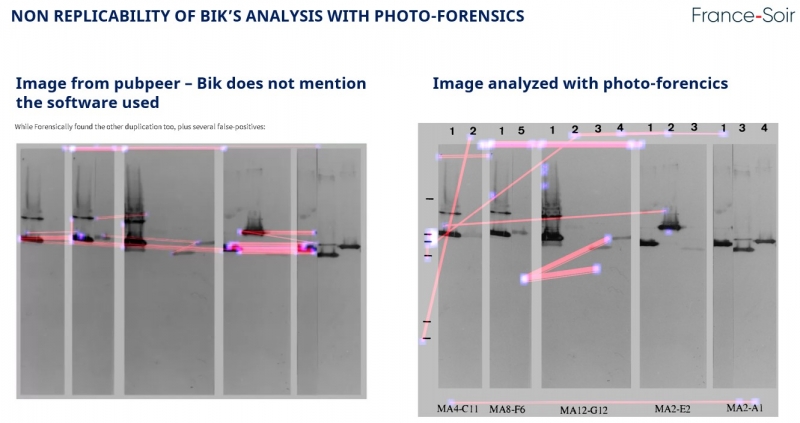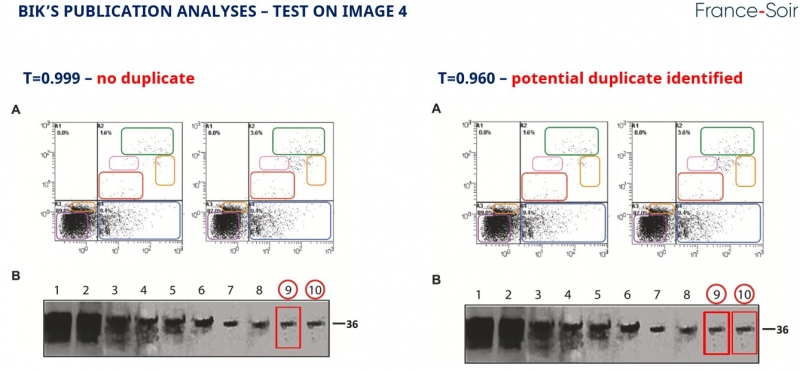
FranceSoir – midjourney The biter being bit before the backlash. Bik keeps seeing copy and paste everywhere, so she finds some, but they are not!
In the wake of Elizabeth Bik's allegations of fraud, many of which are directed at the research center IHU-Mediterranean, we took an interest in her work. And as a matter of fact, one of her articles from 2022 contains many gray areas, and she is far from above suspicion.
For example, on the subject of her past experiences, she declares that she left uBiome in 2018. uBiome is an American start-up subject in 2019 to a resounding bankruptcy and an FBI investigation, forcing the two founders to leave the USA in a hurry and take refuge in Germany! Elizabeth Bik was the company's scientific director and wrote numerous articles, published with the uBiome founders. She did not ever request a retraction of these papers, even though she knew that the microbiota tests sold by the company didn't work. An investigation into the matter revealed substantial insurance fraud, as old samples were re-analyzed and billed to the insurance company a second time! As a conscientious scientist, Elisabeth Bik couldn't have not been unaware of this. The lack of clarity surrounding this situation has been confirmed by microbiome specialists. For them, “Bik made a deal with the founders or federal investigators“.
Another gray area concerns her real date departure date from uBiome. Bik stated on X that it was in 2018, however, on January 9, 2019, she was still communicating about her participation in a health conference organized by the investment bank JP Morgan. Despite France-Soir reaching out to her on two occasions, she was not available to answer our questions…

A verification of Elisabeth Bik's fraud claims could do no harm. After all Bik claims she specializes in identifying photo frauds and photo duplicates. Therefore her analyzes should be replicable. Using Charles V., expertise in computer graphics, we found numerous inconsistencies in Bik's analyses. Could this form part of reasons why she was unavailable to respond to our questions?
Hereafter, we present the analyzes conducted and the reasons why Bik is so wrong in her conclusions, which could be linked solely to problems of definition of the images published. These errors yield several consequences as they contradict the numerous fraud accusationsBik made regarding many scientists. Hence contributing to casting doubt on their work and consequently muddying their reputations.
Introduction to the verification analyzes of BIK's claims
Elisabeth Bik specializes in “detecting studies that she believes are tainted by fraud”. To this end, she uses the Pubpeer platform, which presents a series of tools designed to strengthen the traditional peer review process, notably by allowing comments from scientists and members of the public. A kind of social network for exchanging information on science.
On her website, Bik claims to be a “scientific integrity consultant” with “1069 retractions, 149 expressions of reservations, and 1008 Corrections (as of November 2023). Bik specifically targets IHU-Mediterranean publications.
Therefore Charles V. looked into Bik's allegations concerning several IHU-Marseille articles. Let's look at the reanalysis of Bik's claimed fraud discovery.
- Erroneous conclusions on the first reanalyzed article
Let's take a look at the article“UUsing rpoB genetic analysis to detect and identify Bartonella species” published on February 1st, 2001. Bik commented on Pubpeer on the similarity in some areas in a photo, implying that this might constitute fraud.

Ms. BIK's comments are as follows: “In images 3 and 4:
- Boxes of the same color show areas (some including stripes) that are more similar than expected.< /li>
- The green boxes show clear background transitions.
- The area above the stripes in lanes 1 to 5 of figure 4 also appears to show repetitiveness.”
< p>She adds that the “image has been made darker to bring out more features. This is probably far from the case, but would the authors still have the original photos on gel?”

Verification of the first article challenged by Bik
It's time to check Bik's assertions. After all, in science, the important thing is replicability, but it's also a question of tools and methods. The verification process is explained below.
In order to verify the photo, we extracted the image challenged by Bik from the original PDF file to guarantee its authenticity. Its properties and characteristics are as follows: img60.png PNG 1960×1198 1960×1198+0+0 8-bit Gray 256c 471046B 0.000u 0:00.000
Bik claims, without any real evidence, that two areas of the photo are duplicated.

Using simple photo analysis tools, and after detailed examination, Bik's argument is wrong. This cannot be a duplication, but rather two areas which, although look visually similar, cannot be the result of a duplication.
The biter being bit.
Let's take a look at Bik's completely erroneous conclusion, based on two methods.
First method: let's check whether “areas identified as duplicated” are really duplicated!
The photo on which there are allegedly duplicated areas is in the picture below.
Using image editing software (GIMP):
- The Bg areais extracted. This area is 84 pixels wide by 51 pixels high;
- A copy-paste of this area is duplicated on the photo to create a test area. This makes it possible to duplicate with certainty the area that is supposed to have been duplicated, the famous hypothesis put forward by Bik.

A Computer graphics software can be used to find out if there is a sequence (or pattern) in this photo. Given that part of the image has been duplicated on the picture, the software should technically find this sequence.
The recognition algorithm uses three parameters: the source image, the pattern image (the small exception of the area of interest) and a precision threshold ranging from 0 to 1 (1 being the exact image, 0 corresponds to matching everything in the entire photo).
At a 0.999 threshold, both the pattern and the copy-pasted control are recognized, and no other areas are detected. By lowering the threshold to 0.97, three zones are identified as identical. This is what Elisabeth Bik was able to detect and draw conclusions about duplication and therefore fraud.
It would appear that she didn't go any further, which is rather imprecise, to say the least! There is a 3% difference between the source image and the new area found, which can be calculated from the differences between the thresholds used to identify the pattern (0.999 – 0.97) x 100 = 3%. In terms of pixels, i.e. the number of points used to represent the image, 3% of the pattern's area, i.e. 129 pixels, are different, or 3% of the difference between all the pixels in the image detected: this 3% variance demonstrates the impossibility of a copy-paste operation.
The analysis below shows that, at a 0.95 threshold, a fourth zone could have identical characteristics. At a 0.90 threshold, a multiplicity of zones appear.

Discussion and analyses:
- At the .999 threshold, only two zones are identical. If the zones identified were really duplicated, as Bik claims, we should have found three identical zones. This is not the case. Bik therefore makes a fundamental errorin not performing this analysis, which would have enabled her to verify that the zone she identifies as duplicated is not in fact so. She did not, as she should have done in quasi-exact science, try to reject her hypothesis.
- One problem could be the compression of the JPEG image in the PDF file. The verification was carried out by compressing the image file to 80% and the same result was obtained, which means that JPEG image compression plays no role in this situation.
-
To take the analysis a step further, a 0.97 threshold search for “duplicated areas” was carried out in an image where the degree of certainty of the absence of copy-paste is close to 100%. Let's take a NASA image, of Jupiter to be exact.
Scanning the entire image, for each point a small rectangular area is taken and a clone search is launched, displaying in a red rectangle whether a clone is found at 0.97.< br>With Jupiter, here's the result! So if BIK was telling the truth, she should also denounce the James Webb telescope images as fraud.
Moreover, the colometry in Pubpeer is different from the original image in the PDF file, and Bik writes in her article that “the images were further examined for evidence of duplication or image manipulation using the color adjustment tool in the Preview software on an Apple iMac computer“.
Ironically, if Bik turns off her screen, or sets the brightness to zero, she'll find a big copy and paste of black. Irony aside, a screen can be calibrated, and there are devices that allow you to do so.

In conclusion, these non-automated, non-reproducible image analysis techniques are not scientific and are purely subjective.
Methodology 2: Identifying highlights
Bik may not be using an automated, reproducible scientific approach to identify the frauds, but we felt it's important to test another method.
The second method used is that of comparing remarkable pointsin the image using a high-performance detection tool, FAST Feature Detector.
This tool is often used for point tracking in image stabilization. The assumption is: if two areas are similar, they have the same remarkable points. (https://docs.opencv.org/4.x/df/d0c/tutorial_py_fast.html)
Here's the result obtained on the same image. The result is incontrovertible, confirming the hypothesis that there has been no copy-paste as suggestedby the fraud hunter: between the original zone and the copied zone, the remarkable points are similar, whereas for the zone “imagined” by Bik, they are different not only in their cardinalities, but also in their positions. This is compatible with the first methodology

The first step is to zoom 1100% into the image – a naked eye can see that the areas are different.

Zooming at 1600%. Same result.

Third publication verification on an 2005 article(Bartonella vinsoniiarupensis as an agent of blood-culture-negative endocarditis in humans). Bik also claims duplicated zones problems, which she reports on Pubpeer:

We verify Bik's analysis by demonstrating that the online service she used is not 100% reliable.

We create a duplicate of the zone that Bik considers identical by checking with the matching application used in the very first check: at the 0.999 threshold, there is no duplicate zone identified, but there is one at the 0.97 threshold. Déjà vu: same result, same conclusion.

In response to her Pubperr comment and argument: “…Forensically also found the other duplication, as well as several false positives”. However, using the FotoForensics software, with the default settings, we don't get the same results(illustration below). In science we should obtain results replication.

This is an unscientific analysis, as Bik doesn't indicate how she managed to achieve this result, which is therefore not replicable.
Sherlog can be used to display highlights: although geographically “fairly” close, they are different, and so are their coordinates.

Sherlog offers several methods for detecting cut-and-pastes
With BRISK (Binary Robust Invariant Scale Keypoint): no detection. With the ORB Oriented FAST and Rotated Brief, with a sensitivity threshold of 5% matching, no copy found.

With a sensitivity threshold of 10%, we find results that could be similar to those challenged by BIK.

Finally, with the AKAZE (Accelerated KAZE) method, no copies are detected.

- Analysis of one of Bik's publication – https://journals.asm.org/doi/10.1128/mbio.00809-16
Our analysis and methods would not be complete if we did not apply them to a search for duplicates in a study published by Bik.
Using the same methodology, we took a look at image 4 from her publication, and more specifically at zones 9 and 10. At 0.999 threshold , no duplicates are identified, whereas at 0.96, one zone is identified as duplicated!

In image 2, no duplicate at the 0.999 threshold, but a duplicate at 0.99. This could be a duplicate image, as the difference is very small indeed. However, this is a Bik publication, so it would be churlish to make such a claim. Unless this is a demonstration that “charity begins at home”, and that Bik should have checked his methods on his own images.

The difference is visible to the naked eye by simply by placing the zones side by side.

After verifying Bik's analyses, we have demonstrated that:
- Her claims are unfounded.
- Her error(s) is/are due to an underestimation of 3% difference.
- The errors are not due to the JPEG compression of the image in the PDF file.
- li>
- Two methodologies have been applied to be sure of the result (although none is indicated, apart from Software as Service).
- The same conclusions have been demonstrated for other publications.
- In addition , we have shown that she does not use the software she herself advises to use on her blog (Forensically).
Her claimed intention to expose scientific fraud is laudable , as scientific integrity is the basis of trust in science. However, one can only wonder about her intentions when she attacks IHU publications. And who pays her to attack the work of researchers with a pseudo-scientific approach that cannot be replicated?
Moreover by using her own fraud-hunting methods on her own publication, the latter is subject to the same criticism . The question remains: why doesn't she verify her method on her own publications before applying it to others?
Bik's conclusions are therefore unfounded, and she should withdraw her commentsat the risk of being called a fraud herself. The bitter biter being bit.
Click to download the analysis.
ALSO READ
Is Elisabeth Bik, “the detector of scientific fraud” who constantly criticizes Didier Raoult, above all suspicion? INVESTIGATION – Elisabeth Bik, self-proclaimed “scientific fraud detector”, has been trying for more than three years to demonstrate, mainly on the Pu site… November 1, 2022 – 6:30 p.m. Company Elisabeth Bik, integrity consultant scientific, can only have played an essential role in the launch of Ubiome's fraudulent billing systems TRIBUNE – The only legitimacy of "clinical" as part of this project was based on publications that were successfully published after evaluation by pa… February 6, 2024 – 5:00 p.m. Opinions
Did you like the article? It mobilized our editorial staff which only lives on your donations.
Information has a cost, especially since competition from subsidized editorial staff requires additional rigor and professionalism.
With your support, France-Soir will continue to offer its articles free of charge because we believe that everyone should have access to free and independent information to form their own opinion.
You are the sine qua non condition for our existence, support us so that France-Soir remains the French media that allows the most legitimate expression.

